I would call true believers — people who
identify with the values of the mining industry, who likely are "soft
racists" and cannot imagine a world without free entry or on the flip
side First Nation self government. Then there is a larger middle group
that basically adopt what we would call "standard operating procedures"
— they do what they are asked and do not confront authority. At the
other end of the spectrum is a smaller group that support change in the
direction of recognizing and respecting aboriginal and treaty rights
and ending free entry.
I think that the true believers actively seek opportunities to
advocate for free entry and mining as the one true faith and take every
opportunity to frustrate any change that First Nations might be
seeking. I think that as people behave, they often adapt their belief
to that behavior.
I think you also have a number of people who act out of their
conception of what it means to be a good bureaucrat, what their duty is
as
officials administering a piece of legislation that is more about the
industry's good than any notion of the larger public interest. As the
controversy over mining grows they may now conceive of themselves as at
war with a world of First Nation, environmentalist and do gooder
enemies and maybe even other Ministries encircling them. Some, I think,
they go along with their true believer colleagues basically because
they are simply afraid to confront authority, afraid to be seen as
cowards, afraid to look soft and weak in the boys club that is MNDM.
We have to ask ourselves: How much is racism; traditional soft racism (
people who exhibit muted social antagonism, contempt, subscribe to
beliefs of inferiority and likely are quick to default into biological
explanations), as an
explanation of the motivation for their hostility to change?
In the true believers I think we have some examples of deep hostility
and pervasive racism. But of course that could be said of many in
Canadian society and is not certainly unique to MNDM.
For me it is interesting how a bureaucracy led by true believers can
control government policy in which the bulk of bureuacrats are not
fanatical racists and barking mad mining promoters , but the resistance
to change takes place anyway. This is a much more
dangerous world, and a much more pessimistic view of the possibilities
for change.
The other explanation for MNDM resistance to change would go something
like this.
The MNDM agenda is a by-product of a commodity boom and a declining
Ontario heartland. What the MNDM really wants to do is to simply create
more mining exploration and mines in Ontario's far north and First
Nations are standing in the way of this.
Likely the "truth" is a mixture of both.
Nonetheless we have a ministry dominated by a free market set of ideas
in which the
First Nations are identified with all sorts of non- market values that
threaten an aggressive industry and bureaucracy —
reverence for the land, respect for elders and tradition , family and
community, a rejection of money before all else- and ultimately some
control over industry access to land. These values are all identified
with
First Nations, and the First Nations become the concrete symbol for
all the values
industry and MNDM don't like.I think there is no denying that racism
plays a part in this story as well.
Our hope in government is in the middle[ I know it's a weak hope]. There is no doubt that the KI
events have humiliated the MNDM true believers.
But humiliation often leads to rage. And suppressed rage can be ugly.
Our best hope now is the middle represented by officials in MNR,
Aboriginal affairs{unlikely but possible] and MOE.
Let's imagine that somewhere in the McGuinty government thinking
people will get over their fear and do the right thing.
Otherwise 40 years from now this generation of MNDM officials will be
the subject of their own truth and reconciliation hearings.




